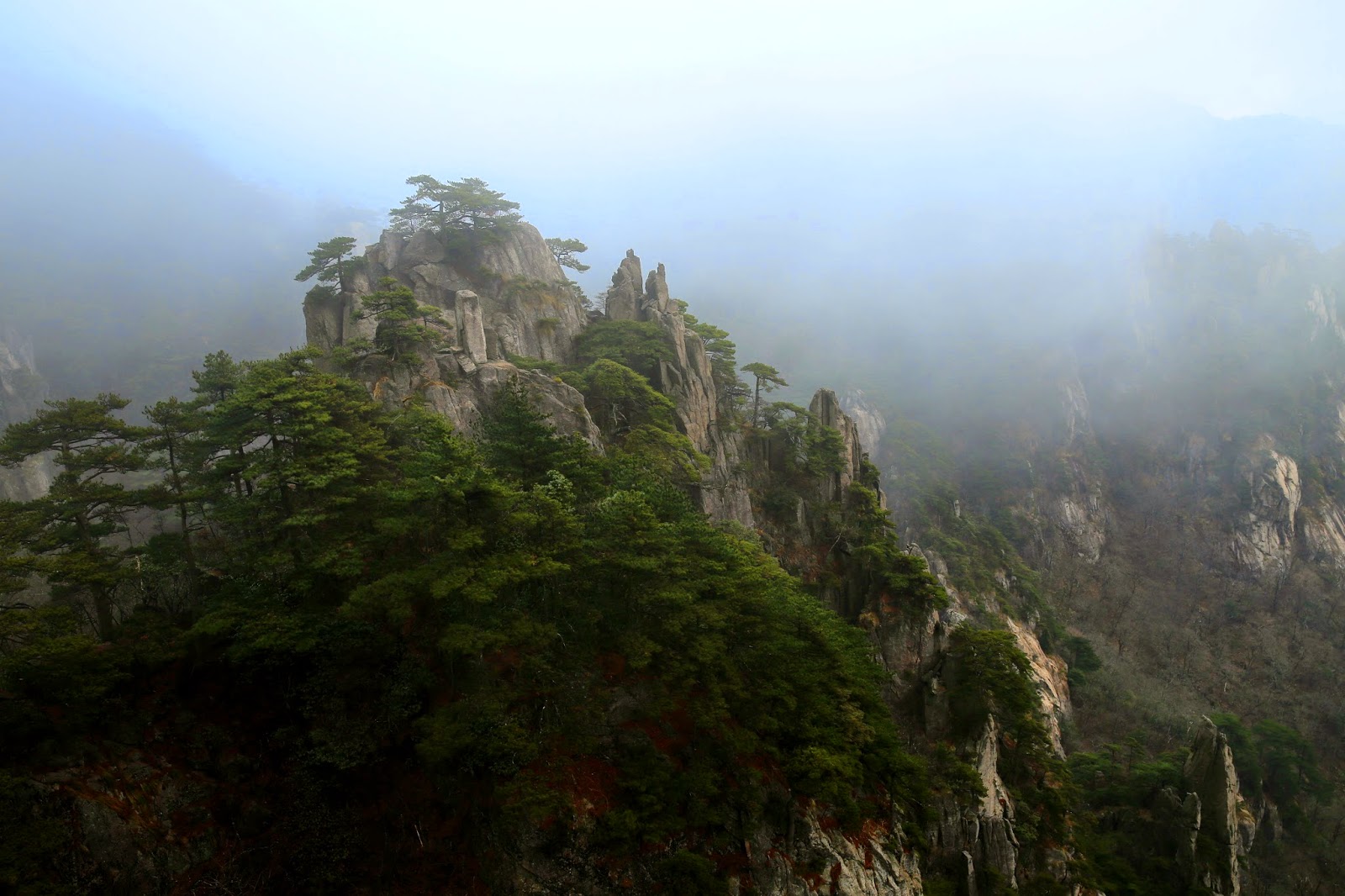Some say that the name Huangshan ( 黄山) only became more widely known after the famous Tang Dynasty poet Li Bai (李白) wrote a poem about it. From the Qin Dynasty until then it was known as Yishan (黟山) because most of its rocks look black-green, as the Chinese character "黟" etymologically means "lots of black".
送溫處士歸黃山白鵝峰舊居 李白 (公元 754)
黃山四千仞,三十二蓮峰。
丹崖夾石柱,菡萏金芙蓉。
伊昔升絕頂,下窺天目松。
仙人煉玉處,羽化留馀踪。
亦聞溫伯雪,獨往今相逢。
採秀辭五嶽,攀岩歷萬重。
歸休白鵝嶺,渴飲丹砂井。
鳳吹我時來,雲車爾當整。
去去陵陽東,行行芳桂叢。
回溪十六度,碧嶂盡晴空。
他日還相訪,乘橋躡彩虹。
To Hermit Wan upon his return to his former residence at White Swan Peak, Huangshan by Li Bai (754 CE) at age 54.
Four thousand arms' length of Huangshan, one bouquet of thirty two lotus peaks
Red ridges between stone columns, golden lotus buds and flowers
I climbed the highest peak and spotted the Pine of Heaven's Eyes below
Where the fairies fashioned their potions, stay signs whence they rose to heaven.
Heard of Hermit Yun Snow, perhaps you'll meet him alone.
To pick essences, you leave the Five Mountains, and climb ten thousand rocks
Retiring to White Swan Peak, drinking from the Well of Red Sands.
When you beckon me with phoenix calls, ready your chariot of clouds
To visit the Mount of the Sun in the east and stroll between fragrant cassia
Repairing to the stream sixteen times, green mountain screens reaching limitless sunny skies
I'll return one day and wade the rainbow upon the bridge
(Tr. El Zorro)
Knowing how variable the weather can be up there but tempted irresistibly by the hope of seeing some snow there, I took the chance to spend a few days there just before the Chinese New Year holidays. My heart sank as the environmentally-friendly coach which took us there from the base of the Huangshan National Park up to the cable car station met with layers and layers of thick dense fog such that we could barely see anything more than 10 feet from our coach window and the sky was completely overcast with grey clouds and the higher the rose the coach, the lower sank my hopes.
I couldn't believe my eyes after my cable car arrived at the station at the "rear mountain" as those going up from the "front mountain" were closed for repairs. The fog was beginning to clear!
But some fog were drifting in from my left and in no time, everything was covered up.
Whenever the fog cleared a little, everyone grabbed their cameras and took such photos as we could before the clouds and fog plunge everything into obscurity again and for a few brief moments, one hears nothing but the sounds of shutters amidst cries of "ahs" and "ohs" and "wows" emanating from contorted bodies above hurrying steps .
Now you see them but a short while later you won't. It's like a huge game of "cat and mouse" with the mountains.
It's true what they say about the clouds and mist up there. is this view what has been called the "18 arhats watching the South Sea" (十八羅漢觀南海)?
The hills and valleys lay in a sea of clouds and mists
You can see the mist circling the valley, a bit like the serpent of Sils Maria in the film of that name I saw a while ago.
The shapes of the mist are constantly changing
You have to click your shutters in as many different settings as you can, hoping that some will come out and discard those that don't.
Sometimes you got to use different lenses and had to change them very quickly before the mist render your changes into regrets.
If the mist clears enough, you can zoom in on the more distant mountains.
Otherwise you got to content yourself with what's closest to you.
The mist is coming in to gobble up the scenery before your camera can catch it.
The distant mountains are now completely gone.
Now everything on the left are almost completely gone.

It's cleared a little now but the distant mountains are completely gone
When the fog is less thick, you can see some of them again.

The fog is coming in again!
It's drifting over the tip of the hills in the middle
And rising upwards to join the other clouds
Now the valley is thick with fogs and clouds
A slightly different angle of the same
Just like those mountains I saw in Chinese ink paintings when I was a child which I then thought were the completely the work of the painter's imagination.
Now I know better. They were "realistic". But instead of using a single point perspective as was done by European painters in the Renaissance, Chinese painters used "multiple focal points" and achieve the "effect" of "distance" by painting those images nearer the viewer bigger and in thicker ink, and those furthest away from the viewer smaller and in the faintest and lightest ink to create effect of different "layers" mountains at varying distance from the viewer and also made use of the fact that hollows into which less light fell would be painted in darker hues. Really clever!
Just like a Chinese ink painting!
Another one when the clouds have moved slightly
Near and far, high and low, darker and lighter!

























沒有留言:
張貼留言